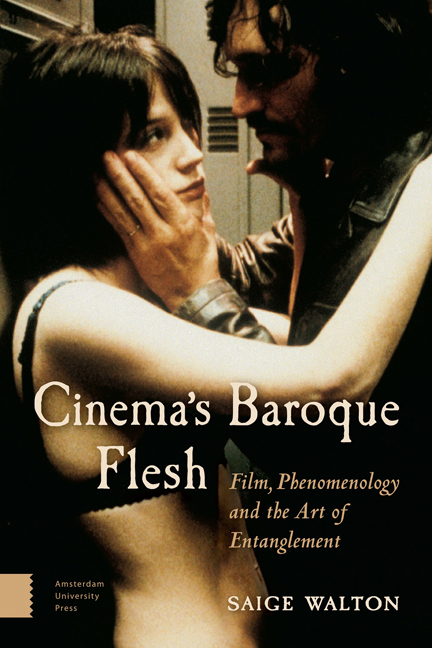Book contents
- Frontmatter
- Dedication
- Contents
- Acknowledgements
- Introduction
- 1 Flesh, Cinema and the Baroque: The Aesthetics of Reversibility
- 2 Knots of Sensation: Co-Extensive Space and a Cinema of the Passions
- 3 Baroque Skin/Semiotics
- 4 One Hand Films the Other: Baroque Haptics
- Conclusion: Or the Baroque ‘Beauty of the Act’
- Notes
- Bibliography
- Filmography
- Index
4 - One Hand Films the Other: Baroque Haptics
Published online by Cambridge University Press: 12 February 2021
- Frontmatter
- Dedication
- Contents
- Acknowledgements
- Introduction
- 1 Flesh, Cinema and the Baroque: The Aesthetics of Reversibility
- 2 Knots of Sensation: Co-Extensive Space and a Cinema of the Passions
- 3 Baroque Skin/Semiotics
- 4 One Hand Films the Other: Baroque Haptics
- Conclusion: Or the Baroque ‘Beauty of the Act’
- Notes
- Bibliography
- Filmography
- Index
Summary
I would like to think that the story of the baroque composition, and the flaunted taste for delirious profusion, is a—calculated but embarrassed, playful and elusive—response to the aporias of tact.
– Jacques Derrida (On Touching, p. 131)There is double and crossed situating of the visible in the tangible and of the tangible in the visible; the two maps are complete, and yet they do not merge into one. The two parts are total parts and yet are not superposable.
– Maurice Merleau-Ponty (VI, p. 134)For Christine Buci-Glucksmann and Martin Jay, the baroque signals a particular scopic regime that harks back to the deeply visual culture of the seventeenth century (La folie, pp. 72–73; Downcast Eyes, p. 43). Adopting a phrase that is taken directly from The Visible and the Invisible, both situate the baroque as a celebrant of the ‘madness of vision’. Buci-Glucksmann, in particular, uses Merleau-Ponty's madness of vision as a synecdoche for the multiplicity and mobility of vision that is instigated by the baroque. Let us, however, return to the original passage to consider its implications for baroque flesh. To quote Merleau-Ponty: ‘There is a sort of madness in vision such that with it I go unto the world itself, and yet at the same time the parts of that world evidently do not coexist without me’ (VI, p. 75). Merleau-Ponty's madness of vision speaks to a reciprocal intertwining between bodies, between bodies and art, or bodies and the world that is typical of ‘flesh’. That intertwining is not exclusive to vision. Merleau-Ponty himself extends the structural reversibility of ‘flesh’ to touch, sound, and sensibility in general (VI, pp. 75, 144).
While the notion of a cinematic baroque has helped contribute to the perceptual and aesthetic variety of film, the film-philosophical resonance between Merleau-Ponty's thought and the embodied experiences of a baroque cinema have yet to be fully explored. To date, the baroque of film and media studies tends to be conflated with spectacular or hyperbolic models of vision and with a cinema of technological display. Buci-Glucksmann, for instance, frames the cinema of Chilean director Raúl Ruiz through what she calls the ‘baroque eye of the camera’ (‘Baroque Eye’).
- Type
- Chapter
- Information
- Cinema's Baroque FleshFilm, Phenomenology and the Art of Entanglement, pp. 185 - 228Publisher: Amsterdam University PressPrint publication year: 2016



